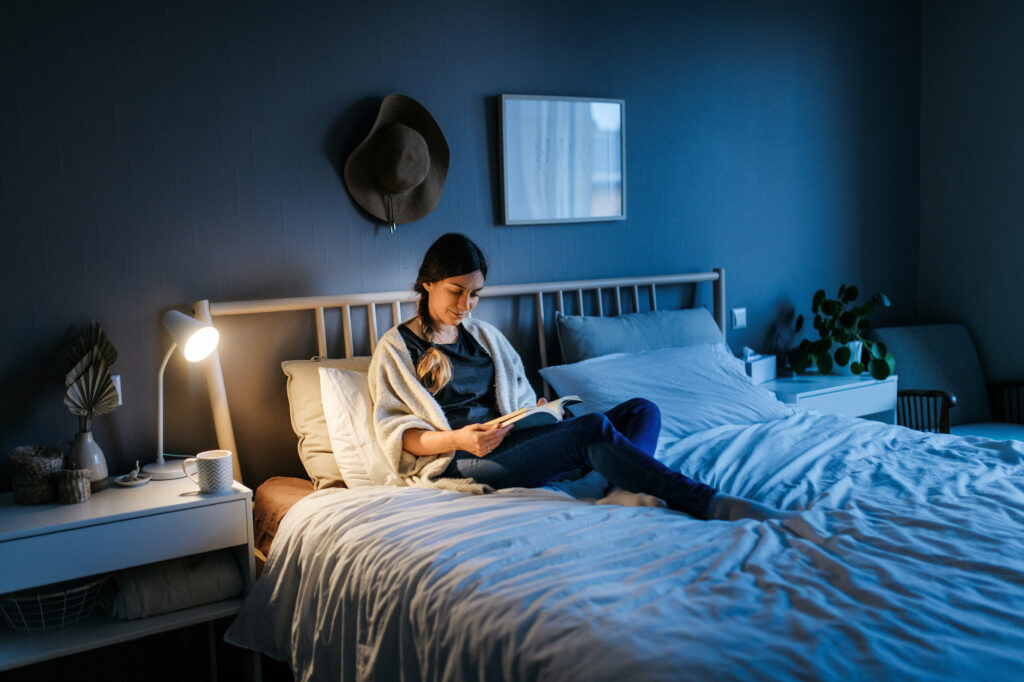
The most disciplined among us have pulled themselves from many a scroll-a-thon before bedtime under the assumption that blue light will not only make it harder to fall asleep, but will take away time from quality sleep as well. But, a new study is questioning just how substantial that risk is, and just how much sleep we might be losing at 11 p.m. on TikTok.
Recent research by experts in Sweden, Australia and Israel found that the relationship between technology and sleep is multi-faceted. (1) The review’s main goal was to help establish a new guide for public health and further define which people the blue light impacts more significantly and how much technology can impact sleep.
The Conversation looked at 73 various independent studies that explored the connection between technology and sleep. A total of 113,370 participants of various ages were included in the review and experts found that the relationship between technology and sleep is a two-way street. While technology was found to lead to poor sleep, poor sleep quality was also associated with more technology use.
In 11 of the reviewed studies, the researchers found that those who used blue light prior to bed fell asleep on average 2.7 minutes later than those who did not. Other studies found that some people slept better following the use of a bright screen.
The review also found that teenagers often used technology at bed because they weren’t sleepy yet. They additionally used screens “to calm down negative emotions and thoughts at bedtime, for apparent stress reduction and to provide comfort.”
The researchers argued that perhaps it’s more important to recognize how technology impacts your personal sleep instead of blaming it all just on how blue light affects your sleep. For some, it seems tech might even be a bit relaxing.
“Technology is programmed to keep us engaged, entertained, and in a flow state. Awareness of technology features is the first step to take control and initiate behavioral changes. This knowledge may also guide harm minimization approaches (e.g., choosing less harmful apps and activities at bedtime),” researchers said.
They added that some people might be more “vulnerable” to the negative effects of technology on sleep and intervention efforts should focus on such characteristics and subgroups (e.g., self-control). For example, individuals with low self-control might instead benefit from adapting their sleep environment so that it limits temptations (e.g., not keeping stimulating technology at arm’s reach in the bedroom), they added.
Information concerning why technology affects sleep needs a bit more investigation: Bright light and arousal do not seem to matter as much as how we manage our screentime in the evening.
“While restricting technology from the bedroom could be an effective solution, people may use technology to facilitate sleep. Therefore, removing all technology from the bedroom may not always be helpful and may lead to more negative thoughts, arousal and eventually fuel insomnia symptoms,” researchers shared. “We encourage practitioners working with young people to ask about the use of technology as a sleep-onset aid and work around harm minimization.”
This research adds to previous findings, such as a 2020 study that found that it would take much higher levels of blue light than devices give off to impact sleep. (2) So what will the future of blue light and sleep’s relationship look like? Some companies point to products meant specifically for this problem, such as this OLED TV that might actually help you sleep better. Through our questionably helpful blue light glasses, we will see what happens next.
Sources
1. Serena Bauducco, Meg Pillion, Kate Bartel, Chelsea Reynolds, Michal Kahn, Michael Gradisar, “A bidirectional model of sleep and technology use: A theoretical review of How much, for whom, and which mechanisms,” Sleep Medicine Reviews, Volume 76, 2024, 101933, ISSN 1087-0792, https://doi.org/10.1016/j.smrv.2024.101933.
2. Dautovich ND, Schreiber DR, Imel JL, Tighe CA, Shoji KD, Cyrus J, Bryant N, Lisech A, O’Brien C, Dzierzewski JM. A systematic review of the amount and timing of light in association with objective and subjective sleep outcomes in community-dwelling adults. Sleep Health. 2019 Feb;5(1):31-48. doi: 10.1016/j.sleh.2018.09.006. Epub 2018 Oct 15. PMID: 30670164; PMCID: PMC6814154.


























